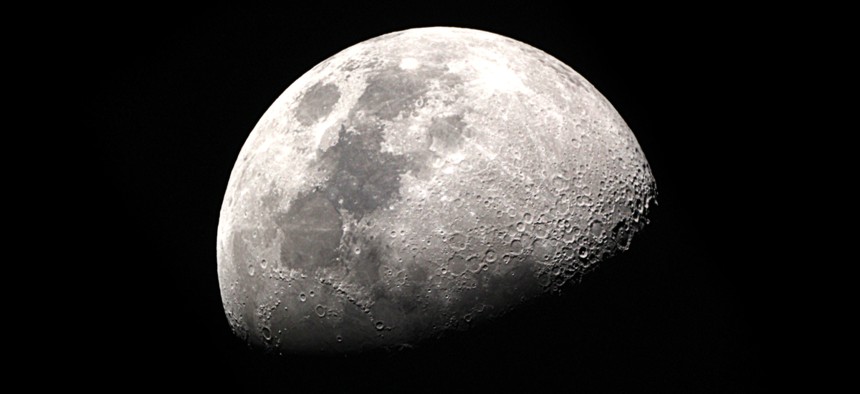NASA Taps Astrobotic to Deliver its Water-Searching VIPER Rover to the Moon

taffpixture/Shutterstock.com
Insiders offered a look at what the forthcoming missions aim to accomplish.
Pittsburgh-based, space robotics technology company Astrobotic will deliver NASA’s water-searching, mobile Volatiles Investigating Polar Exploration Rover—or VIPER—to the moon’s South Pole near the end of 2023, the space agency unveiled Thursday.
Astrobotic was awarded a task order valued at $199.5 million via NASA’s Commercial Lunar Payload Services, or CLPS program, through which American industry partners will swiftly carry payloads and instruments to the moon over the next several years to advance exploration and ultimately help the agency prepare for its forthcoming, ambitious Artemis missions.
“The VIPER mission will search for ice and map resources to bring us a significant step closer to NASA's ultimate goal of a sustainable long term presence on the moon,” Thomas Zurbuchen, NASA's associate administrator for science told reporters during a phone briefing Thursday. “And this will help make it possible for humans to eventually explore Mars and beyond.”
Through Artemis, NASA aims to deliver the next man and first woman to the moon in 2024, and astronauts to Mars in the 2030s. The commercial payloads leading up to then, through CLPS, will support necessary investigations and demonstrations ahead of the efforts and alleviate the burden on NASA of having to ferry tools and resources needed for those experiments. According to NASA’s announcement on the effort, CLPS is “planned to provide a steady cadence of two delivery opportunities to the lunar surface each year.”
Three companies, including Astrobotic, were also already chosen for CLPS missions beginning in 2021. Ahead of VIPER, the robotics business is already set to send its first delivery of other necessary items up to the lunar surface next year. And while Astrobotic will use its smaller, Peregrine lander during the initial mission, VIPER will travel down the lunar surface on the company’s Griffin lander. On the call with reporters, Astrobotic’s CEO John Thornton called its latest NASA-funded opportunity “truly a dream come true” and added that it marks “another exciting milestone for a new era of science exploration and commerce on the moon.” He also emphasized that the company was founded 13 years ago with the specific intent “of making the moon accessible to the world.”
At roughly 1,000 pounds, the VIPER rover will traverse multiple miles across the moon’s surface for roughly 100 Earth days while capturing crucial data that will help inform the very first global water resource maps of the moon—and much more. During the briefing, Lori Glaze, director of NASA's Planetary Science Division, noted that scientists have been studying the moon for decades, “but maybe one of the most surprising findings of recent years was that water ice has accumulated in extremely cold permanently shadowed regions of the moon—one of the coldest places in our solar system—and this water ice could potentially be used by future human exploration missions.” A hurdle, however, is that researchers do not yet fully grasp how it’s distributed or the format it’s in, be it ice crystals, water molecules chemically bound to other materials, or something else.
“And this is where VIPER comes in,” Glaze explained.
The rover will roam over several miles and use its science instruments to detect water molecules on and below the moon's surface, she said, and it will also be equipped with a drill that it’ll use to go beneath the surface and offer researchers new information about the actual location and physical state of water. Glaze added that the scientific data VIPER gathers is also going “to contribute to the selection of future landing sites under the Artemis program by helping [officials] to determine locations where water, ice and other resources could be harvested to sustain humans over extended stays.” Further, the rover will support the agency’s preparation for human exploration by providing new and needed details about the lunar pole’s environment, including its temperature and lighting conditions, plus more.
Astrobotic’s Thornton added that the discovery of water ice at the pole is also “a massive breakthrough for commercial opportunity in space—because we can turn that water into rocket fuel and the moon can become a destination for refueling our spacecraft to explore the moon and maybe even go deeper into space.”
The industry and agency officials also stated how many components of both VIPER and CLPS showcase the ways the space agency is reshaping its path to achieve its lunar exploration goals. On top of working with commercial partners to facilitate payloads, NASA is also sending versions of the rover’s three water-seeking instruments to space—not with it—but on earlier deliveries, which Zurbuchen highlighted is “truly creative” and “totally flips on its head how” the agency usually proceeds.
“VIPER represents a very different development paradigm,” he said.




